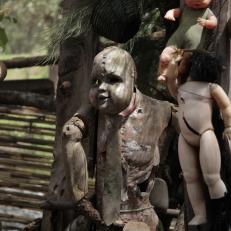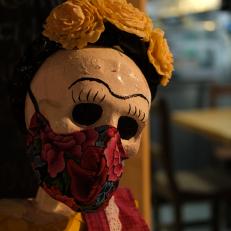Honoring the Departed for Día de los Muertos
Día de los Muertos is a multi-day remembrance celebration in the Mexican tradition. As family and friends prepare for this sacred holiday, explorer and storyteller Emiliano Ruprah captured the colors of this beautiful tradition on the streets of Mexico.
Continue to follow the celebrations on Instagram @emilianoruprah.
Updated: November 3, 2020
Papel picado with Dia de Los Muertos symbolism.
A giant Catrina in downtown Oaxaca City.
Cempasuchil flowers placed on a door frame are meant to call out to the dead and lead them home. Often called “flowers of the dead,” cempasuchil, or flor de muerto, these bright orange and yellow flowers' fragrance is said to attract souls to an altar, home or grave.
An art gallery in downtown Oaxaca City plays on themes of the day of the dead with a massive altar of skulls. The indigenous culture of skulls and the death-goddess Mictecacihuatl is common in pre-Columbian art. Lady of the Dead, Mictecacihuatl, was keeper of the bones in the underworld, and she presided over the ancient month-long Aztec festivals honoring the dead. Since the pre-Columbian era, Mexican culture has maintained a certain reverence towards death.
A copal stand in the 20th of November market. Copal incense was burned in Mesoamerica in ancient times and is still burned for special ceremonies and is often placed on or near Day of the Dead altars as another olfactory element to draw in the spirits. The word copal comes from the Náhuatl word “copalli” which means, “incense”. It is the dried aromatic resin from the copal tree Protium copal (Burseraceae).
A young girl poses with a cempasuchil flower. A mixture of Aztec and European symbolism infuses the meaning of Dia de los Muertos (Day of the Dead) face painting designs. The tradition is a mixture of Catholic beliefs with the religions of indigenous Mexican people.
Hotels, restaurants and shops in Oaxaca’s historic center compete every year by making giant Catrinas.
A mourning Catrina in a plaza in the historic center of Oaxaca.












